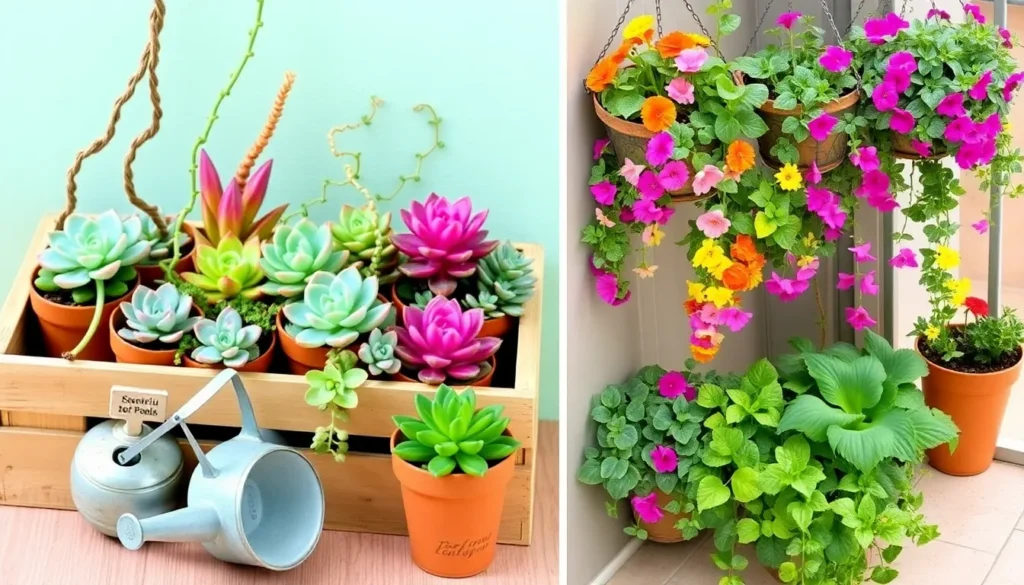Picture this: a lush, vibrant oasis flourishing right outside your window, no sprawling backyard required! Whether you’re a budding gardener eager to get your hands dirty or a seasoned green thumb looking to maximize your space, “10 Easy Small Balcony Gardening Tips” is your passport to turning limited space into limitless possibilities.
In this guide, you’ll discover creative design ideas and practical techniques that transform even the tiniest balcony into a verdant retreat. With these tips, you’ll not only beautify your home but also reap the rewards of fresh herbs, colorful blooms, and a personal escape from the hustle and bustle of everyday life.
Embrace the joy of nurturing your own mini Eden, and gain confidence as we walk you through each step with warmth and enthusiasm. Let this guide inspire you to cultivate your gardening dreams, proving that no space is too small for big ideas and bountiful growth.
Choose Compact Plant Varieties

Gardening on a small balcony requires smart use of space, and choosing compact plant varieties is a key strategy. Consider plants like dwarf tomatoes, bush beans, and mini bell peppers, which are perfect for confined areas due to their smaller stature.
Avoid plants that require extensive root systems or sprawling growth habits, as these can quickly overwhelm a small garden. Instead, opt for herbs like basil, thyme, and chives, which thrive in containers and can be easily harvested for culinary use.
For those who love flowers, look for compact flowering plants such as violas, marigolds, and compact petunias. These plants not only add color and fragrance but also fit well in smaller pots, requiring minimal space to flourish.
Ensure you use a lightweight potting mix to support the health of your compact plants, as this will promote proper drainage and root development. Water these plants regularly, but be cautious not to overwater, as compact varieties are often more susceptible to root rot.
Utilize Vertical Space Efficiently
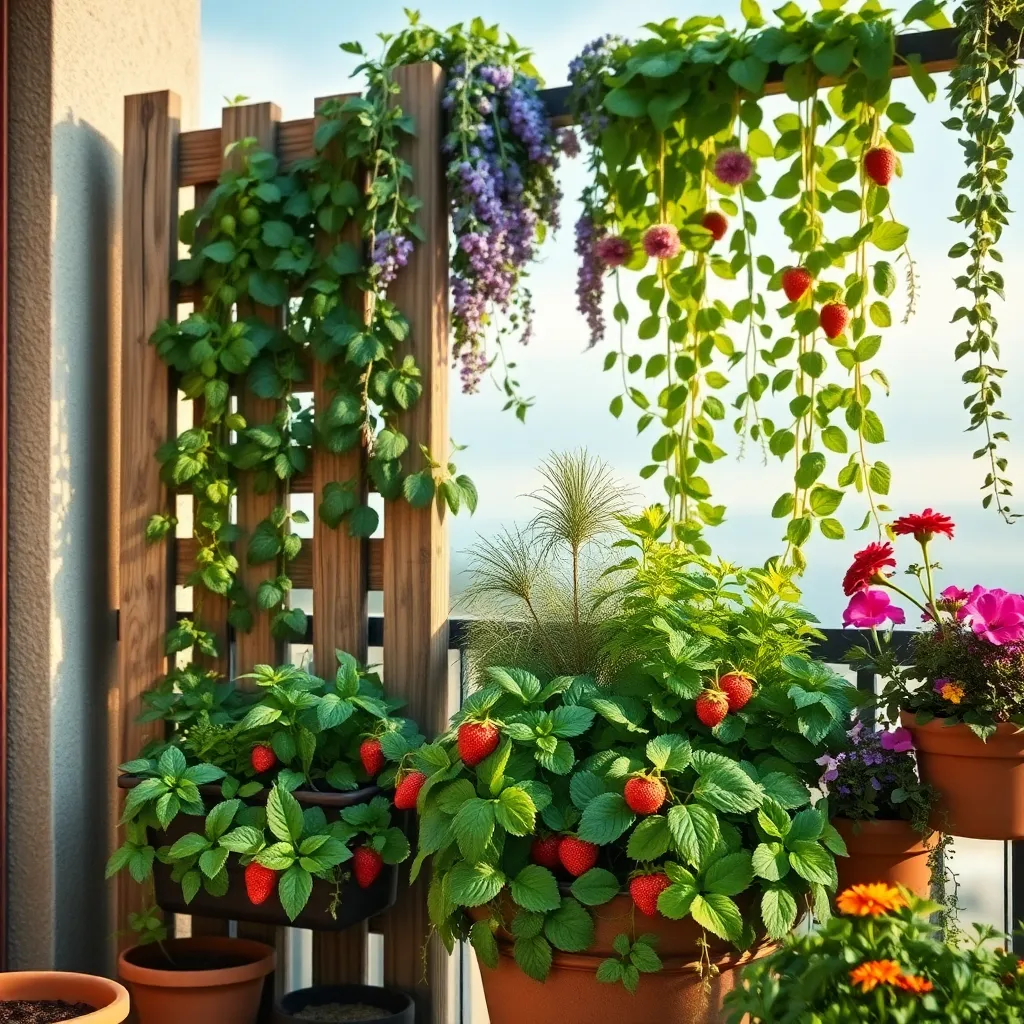
Maximizing vertical space on your balcony is a fantastic way to increase your gardening potential without requiring additional floor space. Begin by installing sturdy, weather-resistant shelves or a multi-tiered plant stand to hold small pots and planters.
Consider using hanging baskets, which are perfect for trailing plants like ivy or strawberries. These baskets can be suspended from hooks affixed to the balcony ceiling, allowing you to make use of all available height.
For those who like an aesthetic touch, creating a living wall can transform your space into a lush oasis. Use modular planting systems or wall-mounted pots to cultivate herbs like basil and thyme, which thrive with good drainage and moderate sunlight.
Advanced gardeners might explore vertical hydroponic systems, which are efficient for growing a variety of vegetables in a small footprint. These systems recirculate water and nutrients, reducing the need for traditional soil and allowing for precise control over growing conditions.
Select Lightweight Containers
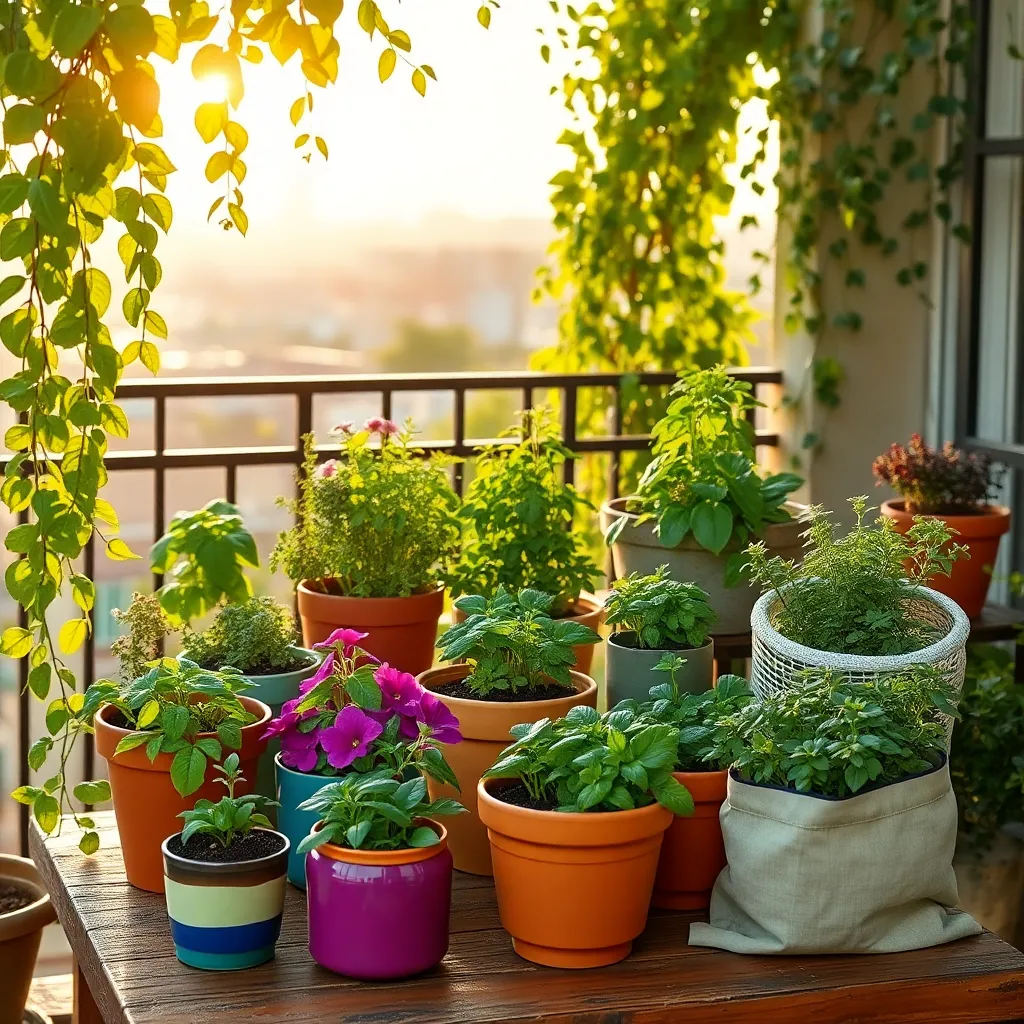
Choosing lightweight containers is essential for small balcony gardens, as it helps prevent overloading your balcony’s weight limit. Opt for materials like plastic, fiberglass, or fabric pots which are durable yet easy to move around as needed.
Consider using self-watering containers, which are not only lightweight but also help maintain consistent soil moisture. This feature is particularly useful for busy gardeners who might forget to water their plants regularly.
For those who prefer a more natural look, consider lightweight resin or composite containers that mimic stone or ceramic. These materials offer the aesthetic appeal of heavier pots without the cumbersome weight, allowing you to easily rearrange your plants for optimal sunlight exposure.
Ensure that any container you choose has adequate drainage holes to prevent waterlogging, which can lead to root rot. If you’re growing larger plants, select a container with a slightly wider base for better stability in windy conditions.
Install Drip Irrigation System
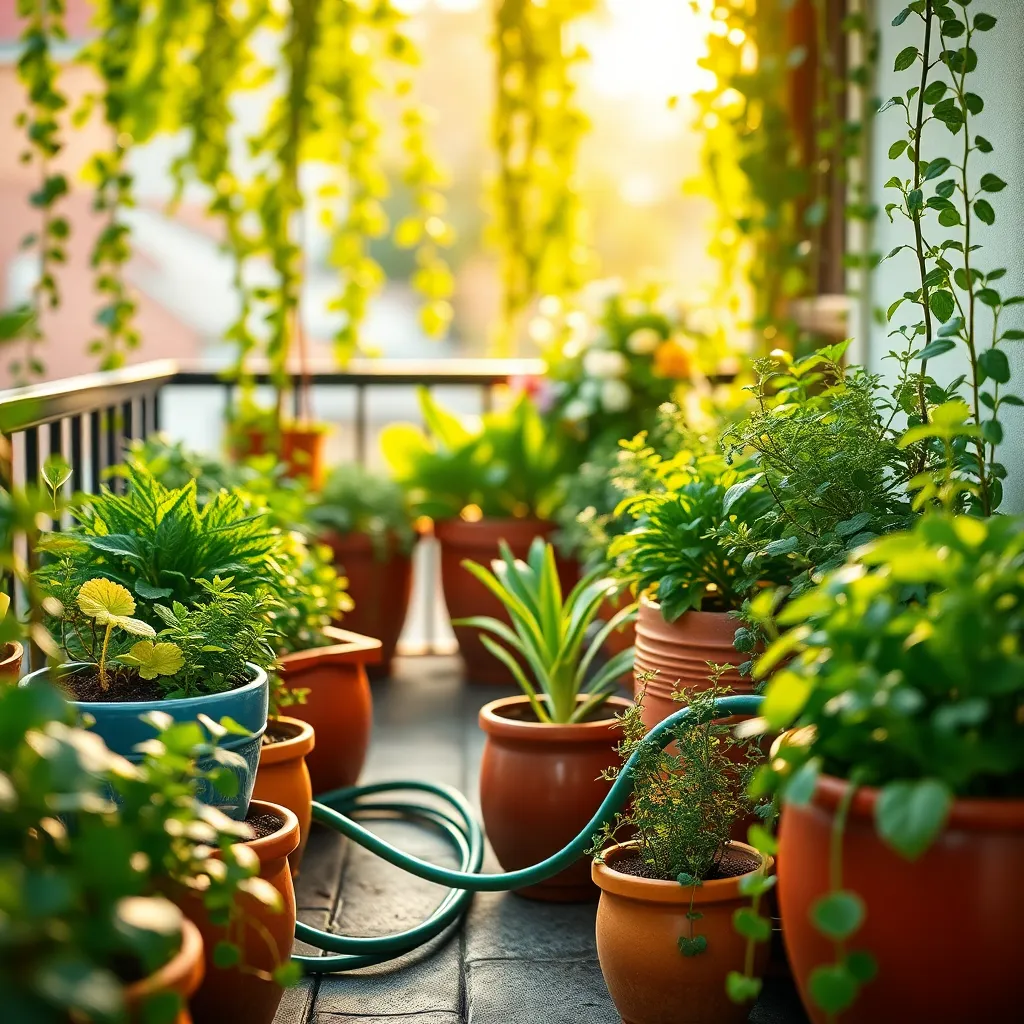
Drip irrigation is a fantastic way to ensure your balcony plants receive consistent and efficient watering. By installing a drip irrigation system, you can save water and time while providing just the right amount of moisture your plants need.
Begin by measuring the size of your balcony garden to determine the ideal length of tubing required. Opt for a system with adjustable emitters, as these allow you to control the water output for different plants, catering to their unique hydration needs.
Position the main tubing along your balcony railing or against the wall, securing it with clips or brackets. This keeps the system tidy and prevents any tripping hazards, ensuring a professional setup that enhances your gardening experience.
Attach emitters to the tubing near each plant, ensuring they are positioned close to the root zone. For plants with similar water needs, group them together to simplify the irrigation process and enhance the efficiency of water distribution.
Regularly check for clogs in the emitters and tubing, as mineral deposits can accumulate over time, especially if your water is hard. By maintaining your drip irrigation system, you ensure it functions effectively, providing a consistent water supply to your beloved balcony garden.
Rotate Plants for Even Sunlight
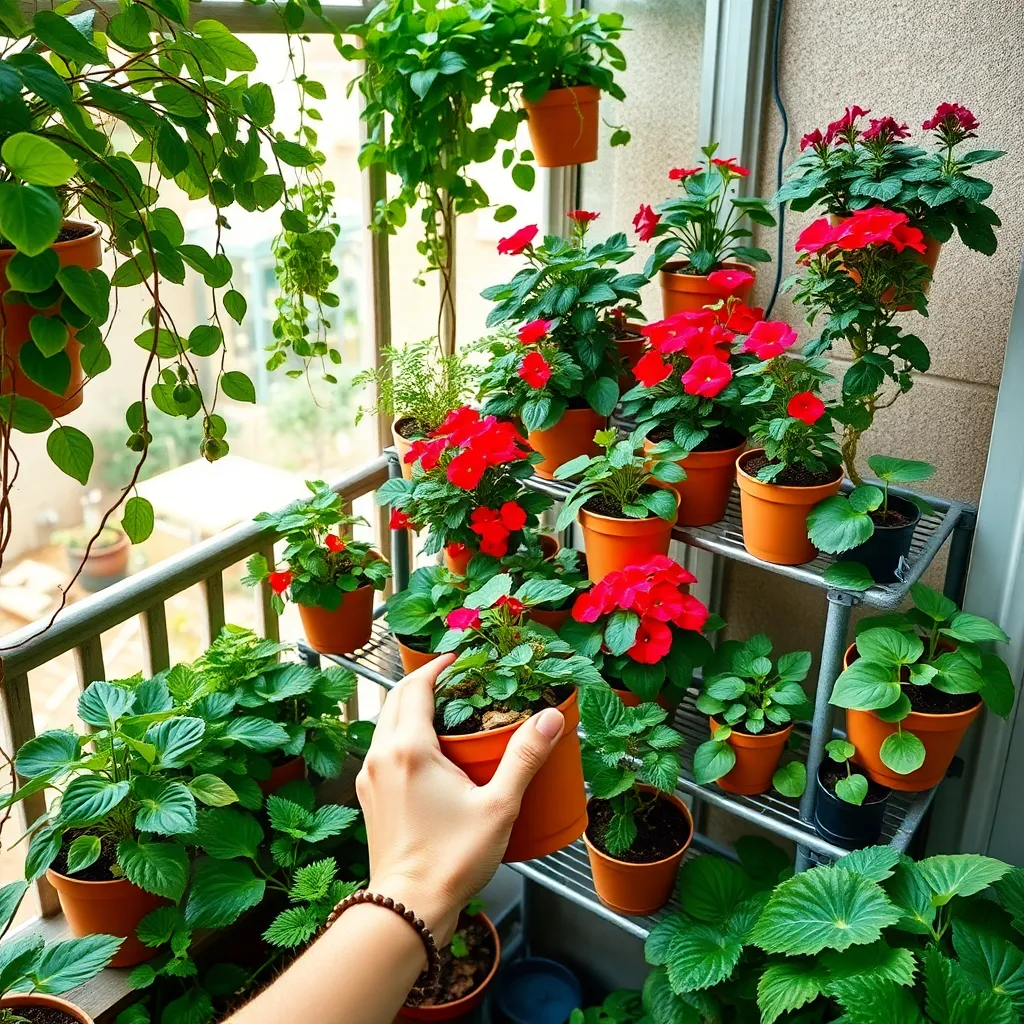
Maximizing the sunlight exposure for your plants on a small balcony can significantly improve their growth. To achieve this, rotate your plants every couple of weeks to ensure that all sides receive equal sunlight.
Balconies often have limited direct sunlight, causing one side of the plant to grow more than the other. By regularly rotating your plants, you can prevent uneven growth and maintain a well-balanced shape.
Beginner gardeners can simply mark their pots with a small sticker to track rotations. For those with more experience, consider mapping out a schedule that aligns with the sun’s seasonal changes for optimal exposure.
Additionally, plants like tomatoes and herbs can benefit greatly from this practice, as they require consistent sunlight to thrive. If you have larger plants, ensure they are in containers that are easy to move to facilitate this rotation.
Incorporate Multipurpose Furniture
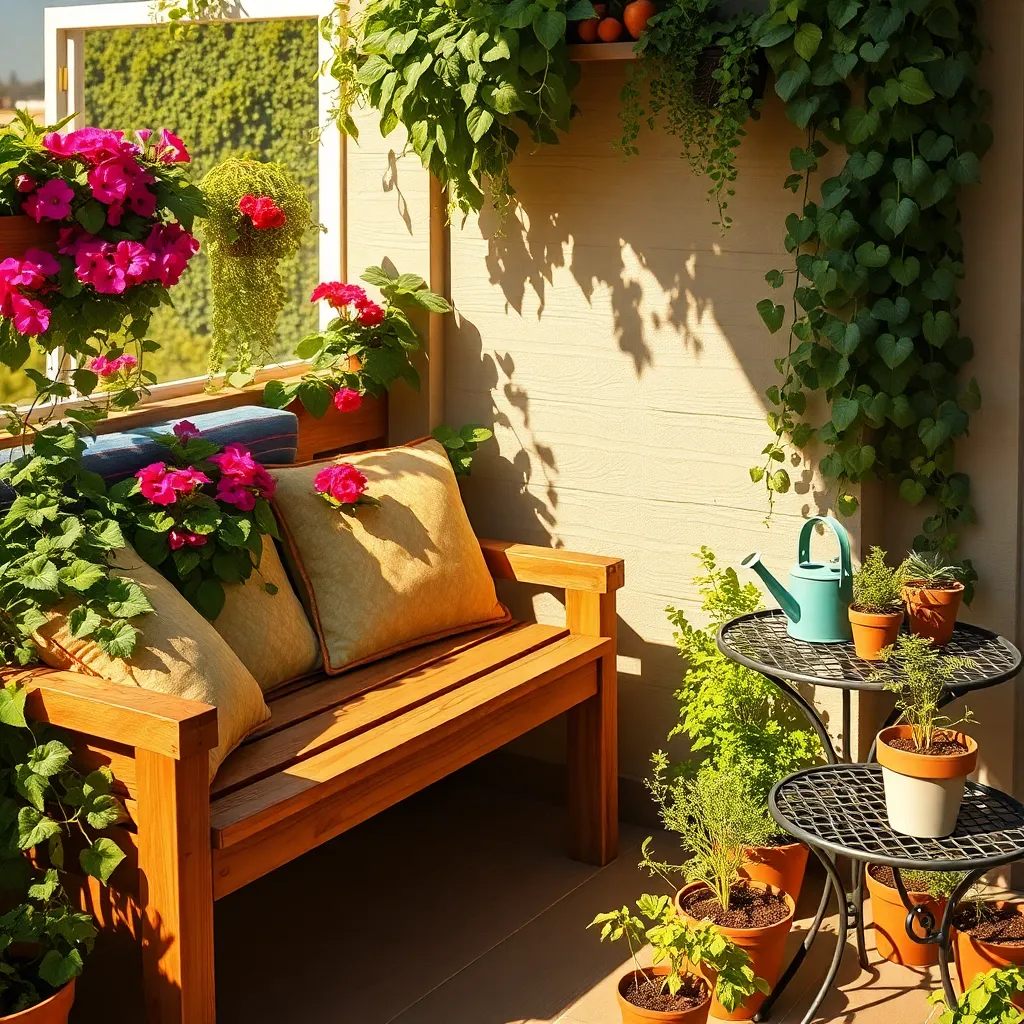
Incorporating multipurpose furniture into your small balcony garden can help maximize space and functionality. A bench with built-in storage can be a perfect spot to store gardening tools, soil, or pots, keeping your balcony tidy and clutter-free.
Consider using a vertical garden stand that doubles as a shelf for your plants. This not only saves space but allows you to create a lush, green wall that adds a touch of nature to even the smallest balconies.
Think about choosing foldable furniture that can be easily moved or stored when not in use. This flexibility ensures you can rearrange your space to accommodate changing seasons or new plants as your garden evolves.
For those looking to add more greenery, use a table planter that combines a functional tabletop with a space for shallow-rooted plants like succulents or herbs. This allows you to enjoy your morning coffee surrounded by your favorite plants, creating a serene and inspiring environment.
Opt for Self-Watering Planters
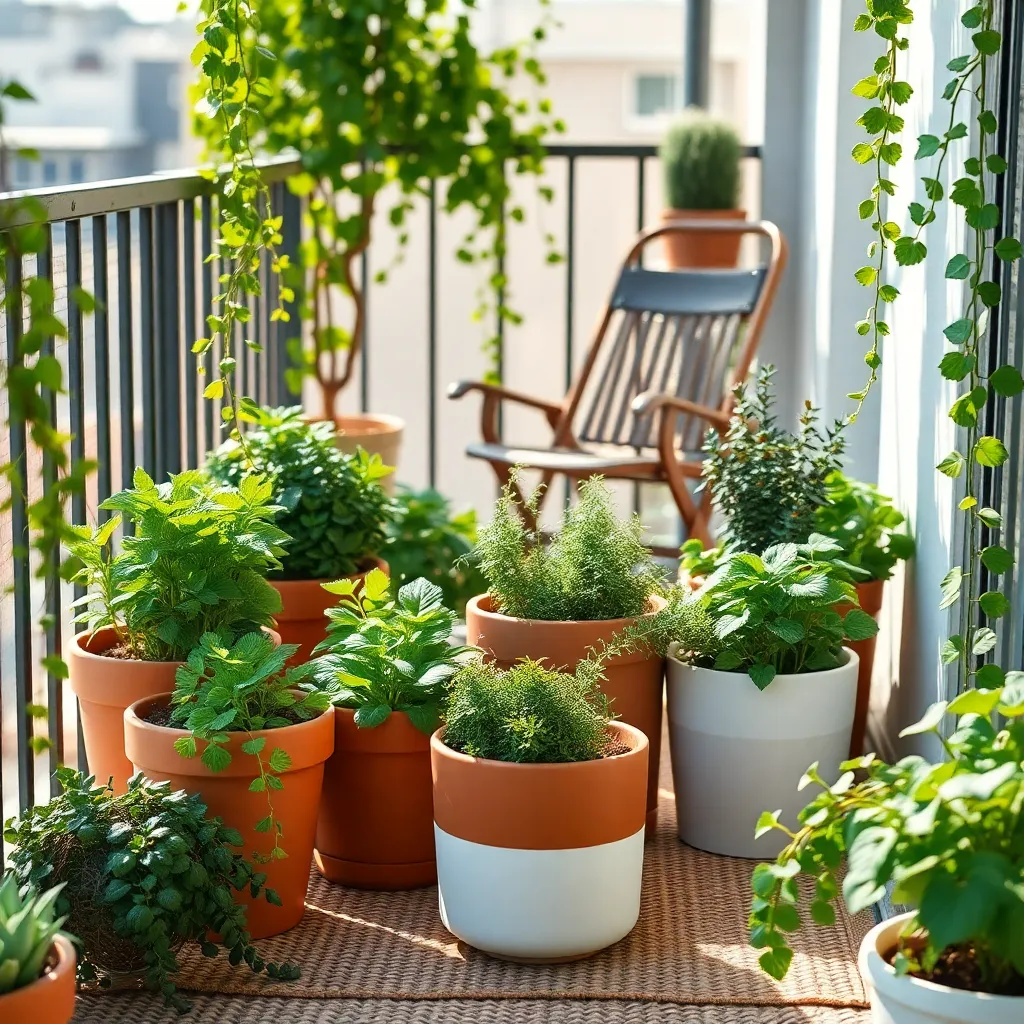
Self-watering planters are a fantastic choice for small balcony gardening. They help to maintain consistent moisture levels, which is crucial for healthy plant growth, especially in sunny or windy locations.
For beginners, these planters take the guesswork out of watering, reducing the risk of overwatering or underwatering. Simply fill the reservoir, and plants will absorb water as needed through a wicking system.
Advanced gardeners will appreciate the efficiency self-watering planters bring to their routine. Watering frequency can be reduced significantly, freeing up time for other gardening tasks.
When selecting a self-watering planter, look for ones with a clear water level indicator. This feature helps you monitor when it’s time to refill, ensuring your plants never run dry.
These planters are suitable for a variety of plants, from herbs to flowers. However, using a lightweight potting mix is essential to ensure proper wicking and prevent root rot.
- Consider adding a layer of mulch on top of the soil to further conserve moisture.
- If growing vegetables, opt for self-watering containers that are at least 12 inches deep to accommodate root growth.
Use Organic Fertilizers Regularly
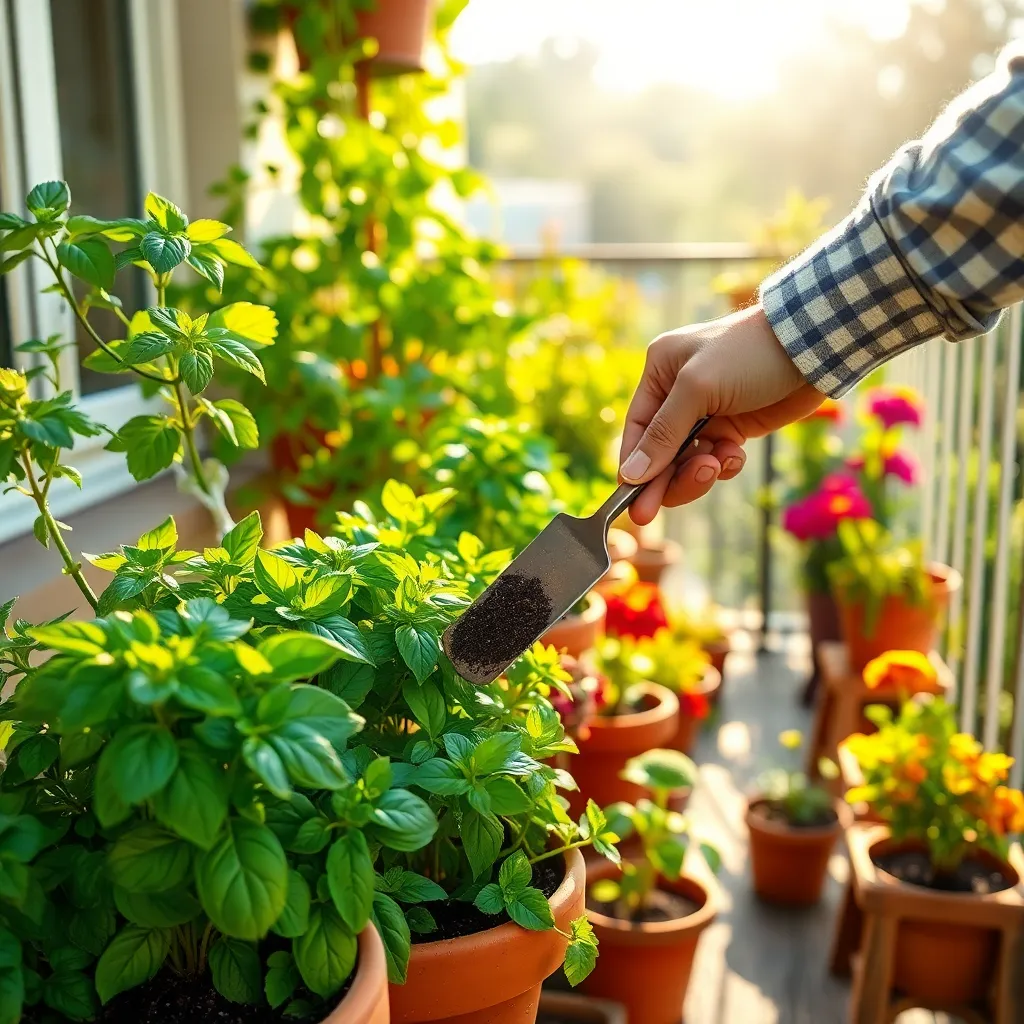
Using organic fertilizers regularly can significantly boost the health of your plants on a small balcony. These fertilizers provide essential nutrients like nitrogen, phosphorus, and potassium in a way that encourages natural growth and soil health.
Consider using compost, worm castings, or well-rotted manure as they are rich in nutrients and improve soil structure. Application is simple: just mix them into the top layer of the soil or create a nutrient-rich tea to water your plants.
Frequency is key; aim to apply organic fertilizers every four to six weeks during the growing season. Monitor your plants’ response—if they show signs of nutrient deficiency, such as yellowing leaves, you may need to adjust the frequency or amount.
For beginners, start with a balanced organic fertilizer to cover a wide range of nutrients. More experienced gardeners might experiment with specific fertilizers tailored to particular plants, such as bone meal for root vegetables or fish emulsion for leafy greens.
Prune to Maintain Plant Size
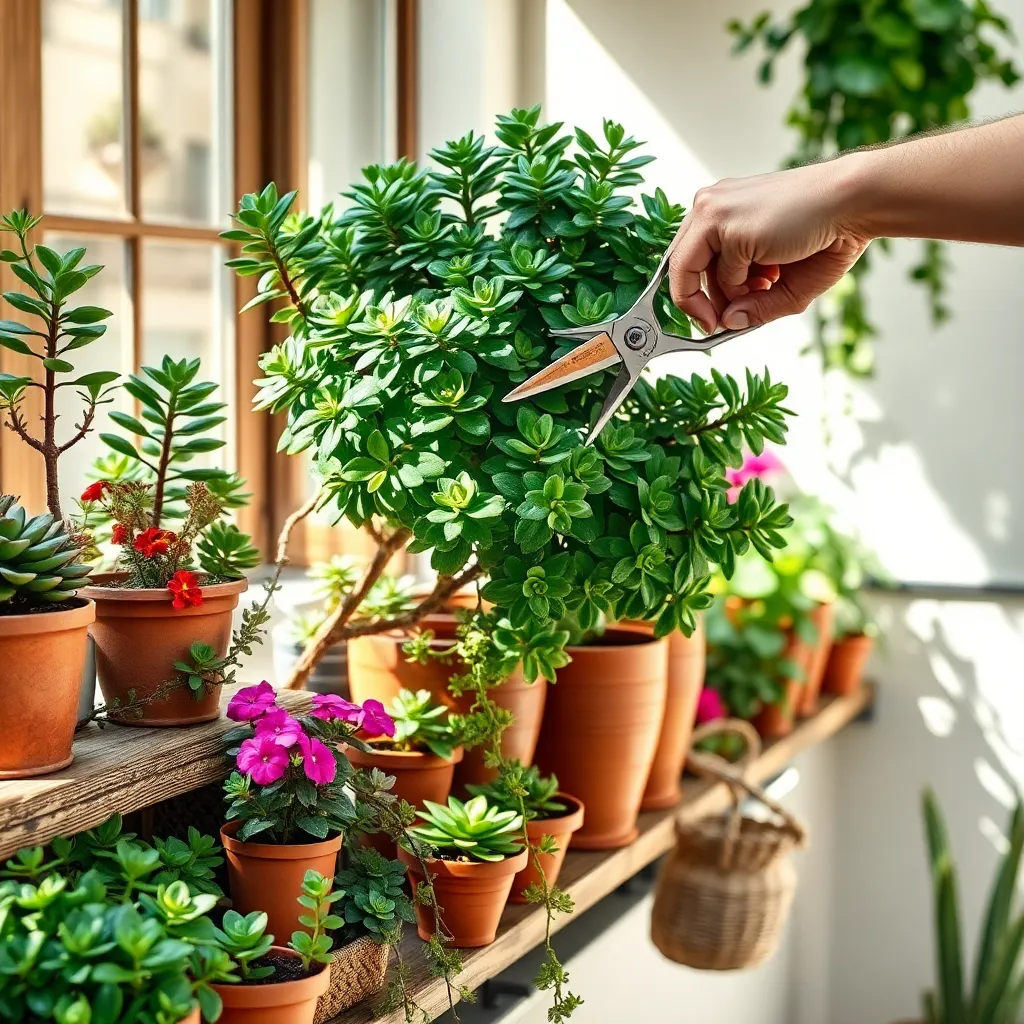
Pruning is essential for maintaining the size of plants in small balcony gardens, ensuring they don’t outgrow their space. Regular pruning not only helps control plant size but also encourages healthy growth and more abundant flowering or fruiting.
To begin, use sharp, clean pruning shears to make precise cuts, reducing the risk of disease. Always prune above a leaf node or bud to promote new growth in the desired direction.
For beginners, start by removing dead or diseased branches, which can sap energy from the healthy parts of the plant. After this initial step, focus on thinning out crowded branches to improve air circulation, which helps prevent pests and diseases.
Advanced gardeners can apply the technique of pinching back, especially for herbs like basil and mint, to encourage bushier growth. Pinching involves removing the growing tips of stems, which prompts the plant to send out side shoots.
If you’re growing flowering plants, timing is crucial—prune right after flowering for those that bloom in spring, and in late winter for summer bloomers. This ensures you don’t inadvertently cut off next season’s blossoms, allowing your balcony garden to flourish year-round.
Create a Seasonal Planting Schedule
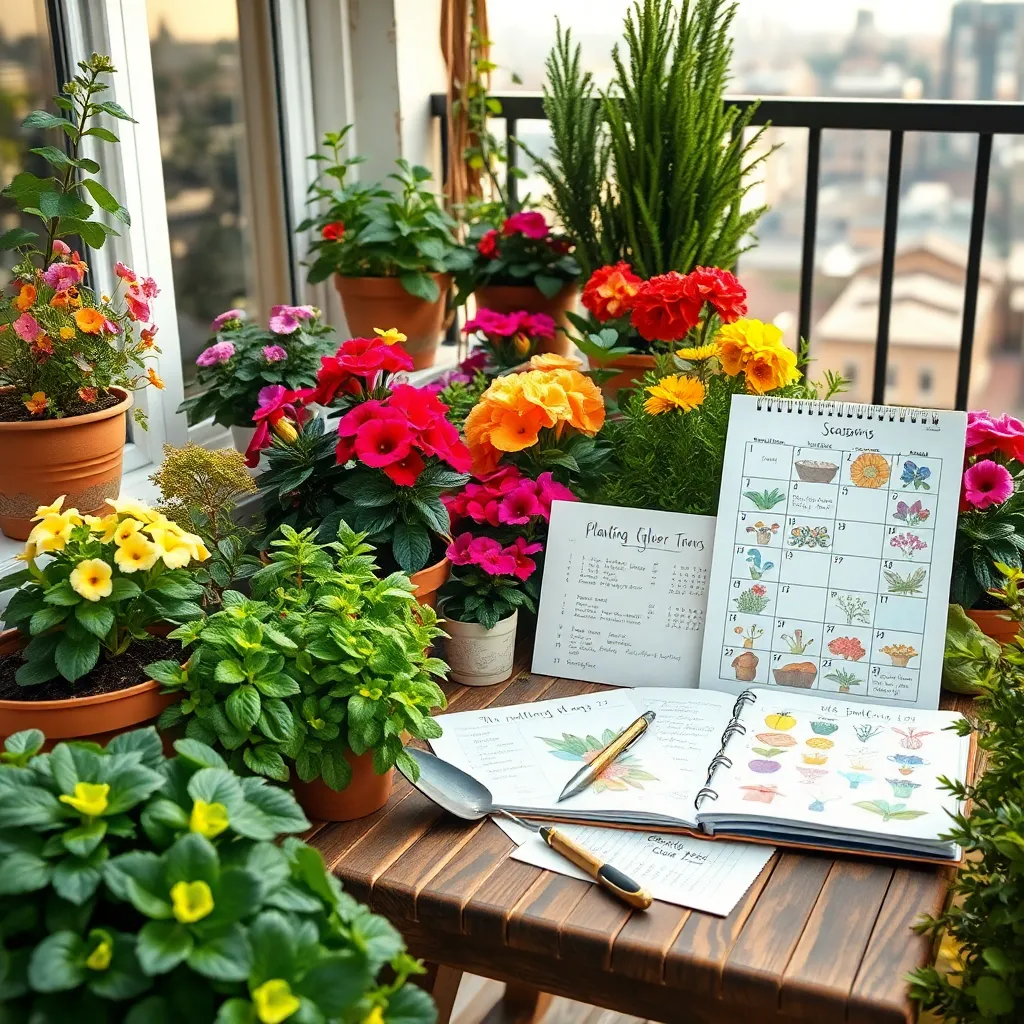
Creating a seasonal planting schedule is essential for maximizing your small balcony garden. By understanding the growth cycles of your plants, you can ensure they thrive throughout the year.
Start by identifying the climatic zones your balcony falls under, as this influences planting times. Use this information to research the optimal planting months for each type of plant you wish to grow.
Consider using a simple calendar or a digital planner to map out your planting schedule. Mark key activities like sowing seeds, transplanting seedlings, and harvesting to keep track of your gardening tasks.
For beginners, start with easy-to-grow plants like herbs, lettuce, and radishes, which have shorter growing cycles. These plants can be sown directly into containers and often yield results within a few weeks, providing quick gratification.
More experienced gardeners might experiment with succession planting, which involves sowing new seeds as soon as a previous crop is harvested. This technique keeps your balcony garden productive and ensures a continuous harvest.
Pay attention to the specific needs of each plant, such as sunlight exposure, watering frequency, and soil type. For instance, Mediterranean herbs like rosemary and thyme prefer well-draining soil and less water, while leafy greens need more moisture and partial shade.
By adhering to a well-planned seasonal planting schedule, you can enjoy a thriving balcony garden year-round. It’s a rewarding endeavor that not only beautifies your living space but also provides fresh produce at your fingertips.
Conclusion: Growing Success with These Plants
In exploring the ’10 Easy Small Balcony Gardening Tips,’ we’ve unearthed key relationship concepts that mirror nurturing a thriving garden. We began with creating a balanced environment, emphasizing communication akin to ensuring plants have the right sunlight. We explored the importance of understanding your partner’s needs, like selecting the right plants for your space. We discussed nourishing your relationship with regular care and attention, paralleling watering routines. Embracing change and resilience, much like adapting to weather conditions, was highlighted. We touched on the beauty of patience and growth, akin to watching your plants flourish over time. The importance of enjoying shared activities, like gardening together, was emphasized, as was celebrating small victories and learning from setbacks, just as you do with plant care.
To start nurturing your relationship today, choose one concept to focus on and commit to a small, tangible action. For instance, plan a quiet evening of open conversation with your partner.
Save or bookmark this article now to revisit these valuable tips whenever you need a reminder. By investing in these nurturing practices, you’re planting seeds for enduring relationship success, ensuring your love continues to blossom beautifully in the future.

